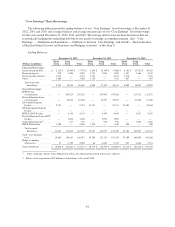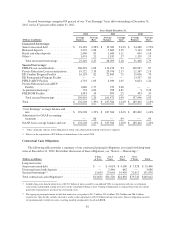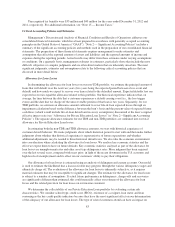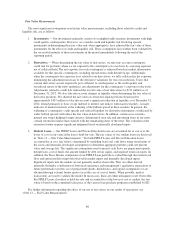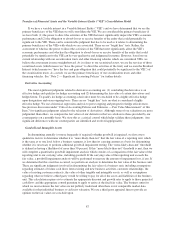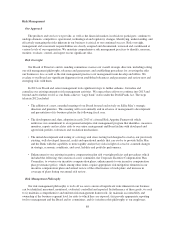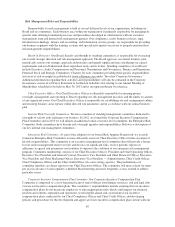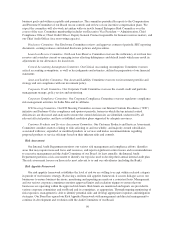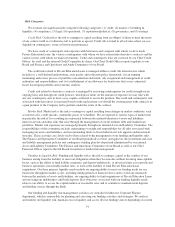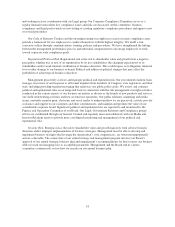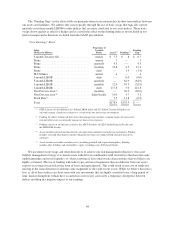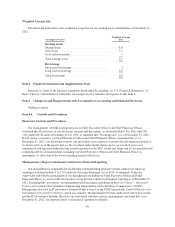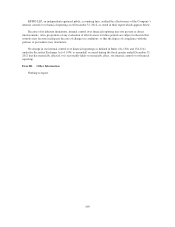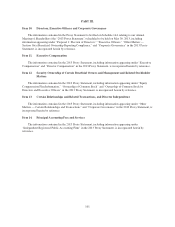Sallie Mae 2012 Annual Report Download - page 93
Download and view the complete annual report
Please find page 93 of the 2012 Sallie Mae annual report below. You can navigate through the pages in the report by either clicking on the pages listed below, or by using the keyword search tool below to find specific information within the annual report.Risk Categories
We evaluate our significant risks using the following categories: (1) credit; (2) market; (3) funding &
liquidity; (4) compliance; (5) legal; (6) operational; (7) reputational/political; (8) governance; and (9) strategy.
Credit Risk. Credit risk is the risk to earnings or capital resulting from an obligor’s failure to meet the terms
of any contract with us or otherwise fail to perform as agreed. Credit risk is found in all activities where success
depends on counterparty, issuer or borrower performance.
We have credit or counterparty risk exposure with borrowers and cosigners with whom we have made
Private Education Loans, the various counterparties with whom we have entered into derivative contracts and the
various issuers with whom we make investments. Credit and counterparty risks are overseen by our Chief Credit
Officer, his staff and the internal Credit Committee he chairs. Our Chief Credit Officer reports regularly to our
Board and Finance and Operations and Audit Committees of our Board.
The credit risk related to Private Education Loans is managed within a credit risk infrastructure which
includes (i) a well-defined underwriting, asset quality and collection policy framework; (ii) an ongoing
monitoring and review process of portfolio concentration and trends; (iii) assignment and management of credit
authorities and responsibilities; and (iv) establishment of an allowance for loan losses that covers estimated
losses based upon portfolio and economic analysis.
Credit risk related to derivative contracts is managed by reviewing counterparties for credit strength on an
ongoing basis and through our credit policies, which place limits on the amount of exposure we may take with
any one counterparty and, in most cases, require collateral to secure the position. The credit and counterparty risk
associated with derivatives is measured based on the replacement cost should the counterparties with contracts in
a gain position to the Company fail to perform under the terms of the contract.
Market Risk. Market risk is the risk to earnings or capital resulting from changes in market conditions, such
as interest rates, credit spreads, commodity prices or volatilities. We are exposed to various types of market risk,
in particular the risk of loss resulting in a mismatch between the maturity/duration of assets and liabilities,
interest rate risk and other risks that arise through the management of our investment, debt and student loan
portfolios. Market risk exposures are managed primarily through our internal Asset and Liability Committee. The
responsibilities of this committee include: maintaining oversight and responsibility for all risks associated with
managing our assets and liabilities, and recommending limits to be included in our risk appetite and investment
structure. These activities are closely tied to those related to the management of our funding and liquidity risks.
The Finance and Operations Committee of our Board periodically reviews and approves the investment and asset
and liability management policies and contingency funding plan developed and administered by our internal
Asset and Liability Committee. The Finance and Operations Committee of our Board as well as our Chief
Financial Officer report to the full Board on matters of market risk management.
Funding & Liquidity Risk. Funding and liquidity risk is the risk to earnings, capital or the conduct of our
business arising from the inability to meet our obligations when they become due without incurring unacceptable
losses, such as the ability to fund liability maturities and deposit withdrawals, or invest in future asset growth and
business operations at reasonable market rates, as well as the inability to fund Private Education Loan
originations. Our three primary liquidity needs include our ongoing ability to meet our funding needs for our
businesses throughout market cycles, including during periods of financial stress and to avoid any mismatch
between the maturity of assets and liabilities, our ongoing ability to fund originations of Private Education Loans
and servicing our indebtedness and bank deposits. Key objectives associated with our funding liquidity needs
relate to our ability to access the capital markets at reasonable rates and to continue to maintain retail deposits
and funding sources through the Bank.
Our funding and liquidity risk management activities are centralized within our Corporate Finance
department, which is responsible for planning and executing our funding activities and strategies. We analyze
and monitor our liquidity risk, maintain excess liquidity and access diverse funding sources depending on current
91


